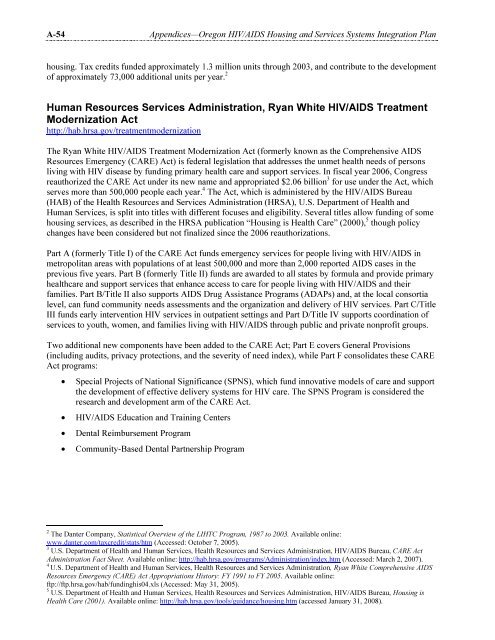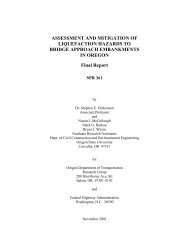Oregon Balance of State HIV/AIDS Housing & Services Systems ...
Oregon Balance of State HIV/AIDS Housing & Services Systems ...
Oregon Balance of State HIV/AIDS Housing & Services Systems ...
You also want an ePaper? Increase the reach of your titles
YUMPU automatically turns print PDFs into web optimized ePapers that Google loves.
A-54 Appendices—<strong>Oregon</strong> <strong>HIV</strong>/<strong>AIDS</strong> <strong>Housing</strong> and <strong>Services</strong> <strong>Systems</strong> Integration Plan<br />
housing. Tax credits funded approximately 1.3 million units through 2003, and contribute to the development<br />
<strong>of</strong> approximately 73,000 additional units per year. 2<br />
Human Resources <strong>Services</strong> Administration, Ryan White <strong>HIV</strong>/<strong>AIDS</strong> Treatment<br />
Modernization Act<br />
http://hab.hrsa.gov/treatmentmodernization<br />
The Ryan White <strong>HIV</strong>/<strong>AIDS</strong> Treatment Modernization Act (formerly known as the Comprehensive <strong>AIDS</strong><br />
Resources Emergency (CARE) Act) is federal legislation that addresses the unmet health needs <strong>of</strong> persons<br />
living with <strong>HIV</strong> disease by funding primary health care and support services. In fiscal year 2006, Congress<br />
reauthorized the CARE Act under its new name and appropriated $2.06 billion 3 for use under the Act, which<br />
serves more than 500,000 people each year. 4 The Act, which is administered by the <strong>HIV</strong>/<strong>AIDS</strong> Bureau<br />
(HAB) <strong>of</strong> the Health Resources and <strong>Services</strong> Administration (HRSA), U.S. Department <strong>of</strong> Health and<br />
Human <strong>Services</strong>, is split into titles with different focuses and eligibility. Several titles allow funding <strong>of</strong> some<br />
housing services, as described in the HRSA publication “<strong>Housing</strong> is Health Care” (2000), 5 though policy<br />
changes have been considered but not finalized since the 2006 reauthorizations.<br />
Part A (formerly Title I) <strong>of</strong> the CARE Act funds emergency services for people living with <strong>HIV</strong>/<strong>AIDS</strong> in<br />
metropolitan areas with populations <strong>of</strong> at least 500,000 and more than 2,000 reported <strong>AIDS</strong> cases in the<br />
previous five years. Part B (formerly Title II) funds are awarded to all states by formula and provide primary<br />
healthcare and support services that enhance access to care for people living with <strong>HIV</strong>/<strong>AIDS</strong> and their<br />
families. Part B/Title II also supports <strong>AIDS</strong> Drug Assistance Programs (ADAPs) and, at the local consortia<br />
level, can fund community needs assessments and the organization and delivery <strong>of</strong> <strong>HIV</strong> services. Part C/Title<br />
III funds early intervention <strong>HIV</strong> services in outpatient settings and Part D/Title IV supports coordination <strong>of</strong><br />
services to youth, women, and families living with <strong>HIV</strong>/<strong>AIDS</strong> through public and private nonpr<strong>of</strong>it groups.<br />
Two additional new components have been added to the CARE Act; Part E covers General Provisions<br />
(including audits, privacy protections, and the severity <strong>of</strong> need index), while Part F consolidates these CARE<br />
Act programs:<br />
• Special Projects <strong>of</strong> National Significance (SPNS), which fund innovative models <strong>of</strong> care and support<br />
the development <strong>of</strong> effective delivery systems for <strong>HIV</strong> care. The SPNS Program is considered the<br />
research and development arm <strong>of</strong> the CARE Act.<br />
• <strong>HIV</strong>/<strong>AIDS</strong> Education and Training Centers<br />
• Dental Reimbursement Program<br />
• Community-Based Dental Partnership Program<br />
2 The Danter Company, Statistical Overview <strong>of</strong> the LIHTC Program, 1987 to 2003. Available online:<br />
www.danter.com/taxcredit/stats/htm (Accessed: October 7, 2005).<br />
3 U.S. Department <strong>of</strong> Health and Human <strong>Services</strong>, Health Resources and <strong>Services</strong> Administration, <strong>HIV</strong>/<strong>AIDS</strong> Bureau, CARE Act<br />
Administration Fact Sheet. Available online: http://hab.hrsa.gov/programs/Administration/index.htm (Accessed: March 2, 2007).<br />
4 U.S. Department <strong>of</strong> Health and Human <strong>Services</strong>, Health Resources and <strong>Services</strong> Administration, Ryan White Comprehensive <strong>AIDS</strong><br />
Resources Emergency (CARE) Act Appropriations History: FY 1991 to FY 2005. Available online:<br />
ftp://ftp.hrsa.gov/hab/fundinghis04.xls (Accessed: May 31, 2005).<br />
5 U.S. Department <strong>of</strong> Health and Human <strong>Services</strong>, Health Resources and <strong>Services</strong> Administration, <strong>HIV</strong>/<strong>AIDS</strong> Bureau, <strong>Housing</strong> is<br />
Health Care (2001). Available online: http://hab.hrsa.gov/tools/guidance/housing.htm (accessed January 31, 2008).

















